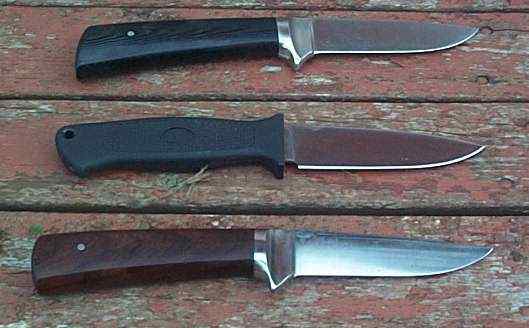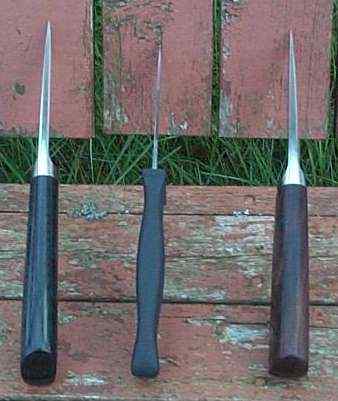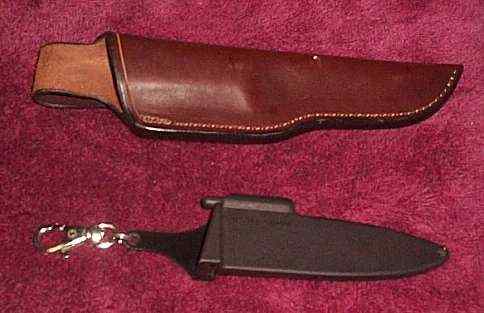
These knives were loaned for a review by Will York. The Deerhunter from A. G. Russell has an overall length of 8.25 inches with a four inch drop point blade ground from 0.080" thick stock. The stainless steel AUS-8A blade is uniformly hardened to 57-59 RC. It is neutral in balance and weighs just 3.4 ounces . The drop point hunters by Boye are similar to the Deerhunter with much thicker blade stock and more hand filling grips. A shot of all three blades :

and showing the blade profile and grip:

The Deerhunter came with a hard plastic sheath which has a swivel and clasp for ease of attachment. The Deerhunter locks into the sheath and can only be released by depressing a little nob. The Boye has a traditional leather sheath :

These are primarily light use blades made to cut very well, all have full flat grinds and similar blade widths. The Boye blades have thicker stock however and thus have a more obtuse primary grind compared to the Deerhunter, seven degrees versus two. The following table lists more specifications :
| Knife | Weight | Blade | Edge | |||
|---|---|---|---|---|---|---|
| Length | Thickness | Width | Thickness | Angle | ||
| Dendritic Cobalt | 143 | 3.6 | 0.213 | 0.91 | 0.010 | 20 |
| Dendritic 440C | 127 | 0.005 | 22 | |||
| Deerhunter | 65 | 3.7 | 0.075 | 1.00 | 0.012 | 14 |
The two Boye blades are almost identical. All the knives are very thin behind the edge, the 0.005" thick edge on the Boye Dendritic hunter is just barely visible.
UPDATE : David Boye recently switched to making Boat knives, however still does custom work [ref].
The blades were used for a variety tasks to explore the cutting performance, edge retention, handling characteristics and scope of work.
These blades are excellent utility kitchen knives. The thin edges and acute profiles allow them to cut efficiently and the short blades make them very ease to handle. On shallow cutting the blades perform all perform equally well. However when slicing thicker vegetables the Deerhunter is much more efficient due to the thin stock.
As a rough check on the differences in the blade materials of the Boye hunters, they were used side by side in the kitchen. After the first week, both were similarly sharp as tested on on some rope. However the Cobalt blade had several small dents about 0.1 millimeters deep and one millimeter long, and a large one about 0.1 to 0.2 millimeters deep and 2 millimeters long.
The blades were sharpened on a butchers steel and finished on a 800 grit ceramic rod. After another week the Cobalt blade had again been more significantly dented and was reflecting light along most of its tip. The steel blade had a small chip, about 0.1 millimeters deep by 0.3 millimeters long and a slightly larger one about 0.2 millimeters deep and 1.0 centimeters long. The blades were sharpened again using a butchers steel and finishing with a 600 grit DMT rod.
After another week the Cobalt blade had a large section about one centimeter, badly dented and rolled which also reflected light readily. The edge was full of dents about 0.1 to 0.2 millimeters deep and one to two millimeters long in this area. The steel blade was lightly reflecting light in a couple of areas but had no significant denting.
At this point the blades were checked for slicing aggression, before and after some light honing :
| Model | After kitchen work | After steeling | After DMT rod honing |
|---|---|---|---|
| Dendritic 440C | 4.2 (1) | 3.6 (2) | 2.5 (1) |
| Dendritic Cobalt | 6.5 (3) | 4.8 (2) | 2.8 (1) |
The numbers refer to how much blade length was required to make a cut. Before honing the Cobalt one was significantly behind by about 50%, this improved with steeling, but needed a true honing to bring the performance back to even with the Dendritic 440C blade indicating that wear was a factor. The loss of material was most likely not due to abrasion, but brittle failure.
Later the blades were used for some light bone cutting including cutting some small chickens in half on a shallow diagonal. The blades held up to this fine with no major damage. The Cobalt version had a large flat spot about two centimeters long just under the tip from the bone contacts. The 440C one was not effected.
During any bone cutting, the effect on the blade is significantly influenced on the control of the cut and the method used. Hacking is much more stressful than a press cut. During any such cutting care should be taken to minimize any twisting of the edge as this will readily induce fracture unless the knife is very tough.
UPDATE : bone density in chickens and other animals is also subject to variation due to age, but size is the critical factor, it would have been informative to note how large were the chickens. As well with the table in the above, it would have been informative to note exactly what was used to test the slicing aggression. Recent reviews illustrate better ways to make such sharpness comparisons [ref].
The blades were used for several weeks cutting mainly rubber tubing and cardboard with a small amount of wire stripping and light scraping. The Boye blades would in general out last the Deerhunter slightly with the Dendritic 440C blade having better edge retention than the Dendritic Cobalt version. The cutting ability was close on all blades with the Deerhunter having a slight advantage on really binding materials (thick cardboard) due to the thin stock.
The Deerhunter sheath was also very versatile. It can be easily clipped onto anything and taken off with ease. As the blade locks in the sheath it can also be carried upside down. It has excellent retention, ease of draw and attachment flexibility. The only real downside is that it is made out of light plastic so its impact durability especially in the cold would be rather low.
The cutting ability is again very similar, and the Boyes again generally have an advantage in edge retention. the Deerhunter's checkered grip however is more secure which becomes an issue after cleaning a few fish. However due to the high cutting ability of all the blades, loss of control was not really an issue.
The blades were also compared in a number of ways to get some more quantitative estimates of the relative performance .
To look at the deep cutting ability the knives were used to point several bundles of pine stakes (3/4" square). Cuts were made with low force and full effort to compare shallow and deep cutting performance, as the former is mainly influenced by the edge profile whereas the latter is effected by the primary grinds as well.
| Model | Low force | High force |
|---|---|---|
| Boye hunter in D-Cobalt | 11.3 +/- 0.4 | 5.4 +/- 0.3 |
| Boye hunter in D-440C | 12.0 +/- 0.7 | 5.4 +/- 0.3 |
| Deerhunter | 14.0 +/- 0.7 | 5.8 +/- 0.4 |
In regards to the raw cutting ability, the Boye blades had a slight advantage but it was not significant. However they cut much smoother. This is due to a number of factors; the more hand filling grip, dropped blade, and more efficient wedging action.
UPDATE : such whittling performance can indeed actually be enhanced with a thicker cross section. As blade profiles thin past a certain point while the penetration is high the wedging is great also. Very thin convex blades tend to be best for such cutting such as an Opinel.
The blades were first compared on cardboard, with both push cutting ability and slicing aggression measured. The knives were used with both a high polish and medium finish. In short, the Dendritic 440C blade had a significant performance advantage over the other blades mainly due to the durability of its edge. The AUS-8 and Dendritic Cobalt edges tended to deform much more readily and tore after extended use, indicating a lower strength. Details :
Another edge retention comparison was performed on half inch hemp rope. The sharpness was determined by the ability to slice fabric under their own weight. A Henckels paring knife (stock profile) from the international line was used as a low performance baseline. The knives had the edges sharpened on a 220 grit, x-coarse DMT 8" hone for a very coarse and aggressive slicing finish. The details :
| Model | Initial | 25 rope cuts | 60 rope cuts | Steeling |
|---|---|---|---|---|
| D-440C | 4.0 (3) | 6.1 (3) | 5.8 (1) | 4.4 (4) |
| D-Cobalt | 4.1 (1) | 6.4 (4) | 8.8 (2) | 5.2 (2) |
| Deerhunter | 5.3 (2) | 8.2 (6) | 16.3 (9) | 9.0 (7) |
| Henckels | 9.0 (8) | 36 (2) | * | 30 (2) |
The Boye Dendritic steel drop point hunter is only slightly blunted and is restored to 100% by steeling. The Boye Dendritic Cobalt blade suffered significantly more degradation and isn't restored to 100% by steeling. The Deerhunter continues the same trend, as does the Henckels knife to an extreme which fails to be able to make any cuts beyond 25. The Henckels also has a poor geometry for rope slicing as the edge runs up towards the tip, the Boye blades are the opposite and thus are excellent rope slicers, the Deerhunter being between the two.
The slight blunting of the Dendritic 440C blades did not stand out by feel when cutting the hemp. However the degradation of the Dendritic Cobalt version was enough to be noticed by feel after the first 25 cuts and its continued degradation could be determined by feedback alone as well. The blunting of the others was more extreme that the loss of aggression on the hemp was so large they could be ranked in performance just by feedback on the hemp alone.
UPDATE : this review was done in 1999-2000 when methods were being developed. The above sharpness testing using the weight of the knives sounded like a good idea at the time, but in retrospect isn't a fair comparison to the lighter blades. Recent reviews illustrate much better ways to make sharpness comparisons [ref]. As well, in general such comparisons should be repeated a few times to smooth out random variations and a few different grits examined.
The Deerhunter is decently comfortable due mainly to its high cutting ability which means little feedback generated during most use. During really heavy cutting the handle is uncomfortable, mainly as my grip is too large for the handle. My pinky is on the lower ramp and my index finger is on the guard which is a bit too square and bites into the web between my thumb and forefinger. The Boye blades have much more ergonomic grips which fill the hand nicer with no sharp contacts areas.
In regards to security both the Boye drop point hunters and the Deerhunter are poor. When wet even light stabs were not possible with the Deerhunter as the hand would simply ramp over the small guard. The Boye blades were slightly better because of the larger guard, but neither knife indexed strong enough in hand to prevent twisting motions from moving the knife. In consideration of course, these are generally light use knives and so when used in the intended scope of work these problems are not often a functional concern.
It would be nice to see the Deerhunter offered in a harder steel, and have the edge run uninterrupted to the grip as on the Boye knives, a slightly longer handle would also be of benefit to some. It would be interesting to see the Boye blades with thinner stock and possibly a checked grip for more retention.
UPDATE : the Deerhunter is now offered in in VG-10 stainless steel at 60-62 RC, and D2 tool steel at 60-62 RC.
You can comment on this review by dropping me an email : cliffstamp[REMOVE]@cutleryscience.com. Feedback can also bee seen in the following ARCHIVED thread on Bladeforums :
Other Deerhunters were also recently reviewed [ref].
| Last updated : | Thu Jun 26 14:05:50 NDT 2003 |
| Thu Mar 30 11:59:56 NST 2000 |